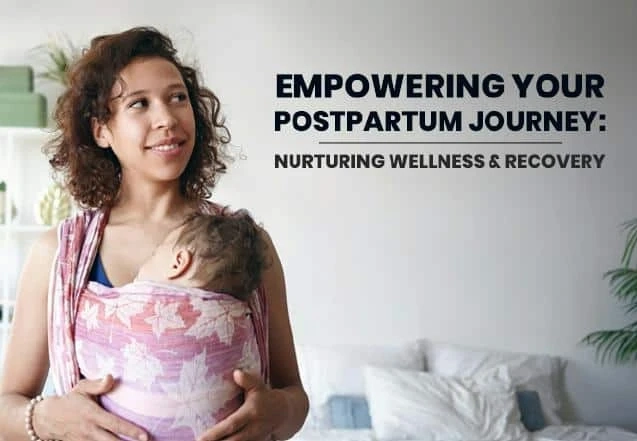Recovering after giving birth to a baby is a process that takes time. It\'s important for new mothers to understand that this recovery doesn\'t happen quickly; it takes a while. Becoming a mother and having a baby can be tough and painful. In the weeks following childbirth, usually around 6 to 8 weeks, it\'s crucial for mothers to take care of themselves. During this time, a mother\'s body goes through many changes, and these changes need special attention. To ensure proper care, it\'s recommended to seek help from a Gynecologist in Lucknow Gomti Nagar, a doctor who knows how to support and guide mothers during this postpartum period.
Recovering After Birth: What to Expect and How to Navigate It
Bringing a new life into the world is a remarkable journey, but it\'s important to acknowledge that it comes with its own set of challenges. Whether you\'ve had a normal delivery (vaginal birth) or a caesarean section (C-section), your body goes through changes that require special care and attention. Here\'s what you need to know about postpartum recovery and some practical steps to navigate each stage:
After Normal Delivery (Vaginal Birth):
- Perineal Discomfort and Soreness: After giving birth, many new moms experience discomfort and soreness in the area between the vagina and anus, known as the perineum. This happens because, during childbirth, this area can stretch. As a result, moms might feel pain, tenderness, and general discomfort for a few days or weeks. Meanwhile to ease this discomfort:
- Take warm water baths or sitz baths to soothe the area.
- Use ice packs to reduce swelling and provide relief.
- Opt for soft seating like cushions to alleviate pressure.
- Episiotomy or Tear Healing: If you\'ve had tears or an episiotomy during delivery, these areas will need time to heal. Although these feelings usually get better with time, it\'s important to talk to a gynecologist in Gomti Nagar about any ongoing or worsening pain to make sure everything is okay during the recovery process. Follow these tips to help you with pain:
- Keep the area clean by gently washing with water and patting dry.
- Use pain relief medications as prescribed by your doctor.
- Begin pelvic floor exercises to improve healing and circulation.
- Vaginal Discharge (Lochia): After you give birth, your body goes through a process where you will have some bleeding from your vagina. This is called lochia and it\'s a normal part of your body healing after childbirth. Just like how a cut heals and may have some bleeding at first, your body is getting rid of extra tissue and blood from inside your uterus as it heals. Here\'s how to manage it:
- Use postpartum pads designed for heavy bleeding.
- Keep an eye on the discharge colour and quantity. If it becomes heavy or foul-smelling, consult your doctor.
- Breastfeeding Challenges: Many new mothers encounter difficulties when they start breastfeeding, such as latching issues and sore nipples. These challenges can be overcome with these steps:
- Seek help from a lactation consultant for proper latch and positioning.
- Apply nipple creams to soothe sore nipples.
- Relieve engorgement by expressing breast milk manually or with a pump.
After Cesarean Section (C-Section):
- Incision Pain and Healing: Following a Caesarean section, commonly known as a C-section, the process of recovery involves diligent attention to the incision site. This surgical wound requires special care to ensure proper healing and minimize discomfort. While some level of pain or discomfort is expected, understanding how to manage it and promote healing is essential for a smoother recovery journey. Here are a few key considerations:
- Take the pain medications prescribed by your doctor.
- Gradually start moving, following your healthcare provider\'s recommendations.
- Keep the incision clean and dry, and change dressings as needed.
- Mobility and Lifting Restrictions: Mobility and Lifting Restrictions refer to the limitations in moving around and picking up heavy things that might occur after having a C-section surgery. When you have a C-section, your body needs time to heal, and this can make it hard to move and lift things like you normally would. To help you recover well, it\'s important to follow these guidelines:
- Slowly increase movement as advised by your healthcare provider.
- Avoid heavy lifting until you receive the green light.
- Gas and Bloating: Gas and bloating can happen after anesthesia and surgery. This occurs because the body\'s normal processes can be affected, leading to discomfort. To help relieve these feelings and feel better, there are some steps you can take:
- Take gentle walks to aid digestion and relieve gas.
- Ensure you maintain proper hydration and consume a well-balanced diet rich in fibre.
- Scar Care: Devoting proper attention to the care of your C-section scar holds paramount importance. Ensuring meticulous care for your scar not only contributes to its healing process but also minimizes potential complications. Following these measures can help promote the fading of the scar over time:
- Maintain cleanliness and dryness at the incision site to avoid the risk of infection.
- Wear loose clothing that won\'t irritate the scar.
- Once healed, consider gentle scar massage to improve tissue mobility.
- Emotional Wellbeing: Adjusting emotionally after childbirth, especially following a C-section, is typical due to hormonal shifts, physical healing, and new parental responsibilities. Surgical aspects and recovery may intensify these feelings and one can overcome these:
- Reach out to your loved ones for assistance and contemplate becoming part of support communities.
- Talk to your healthcare provider about any emotional challenges you\'re facing.
Remember, everyone\'s recovery journey is unique. Be sure to follow your healthcare provider\'s advice for the best possible recovery experience and give yourself the time and care you deserve during this period.



